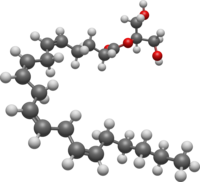
Photo from wikipedia
Rebaudioside D is a sweetener from Stevia rebaudiana with superior sweetness and organoleptic properties, but its production is limited by its minute abundance in S. rebaudiana leaves. In this study,… Click to show full abstract
Rebaudioside D is a sweetener from Stevia rebaudiana with superior sweetness and organoleptic properties, but its production is limited by its minute abundance in S. rebaudiana leaves. In this study, we established a multi‐enzyme reaction system with S. rebaudiana UDP‐glycosyltransferases UGT76G1, Solanum lycopersicum UGTSL2 and Solanum tuberosum sucrose synthase StSUS1, achieving a two‐step glycosylation of stevioside to produce rebaudioside D. However, an increase in the accumulation of rebaudioside D required the optimization of UGTSL2 catalytic activity towards glucosylation of rebaudioside A and reducing the formation of the side‐product rebaudioside M2. On the basis of homology modelling and structural analysis, Asn358 in UGTSL2 was subjected to saturating mutagenesis, and the Asn358Phe mutant was used instead of wild‐type UGTSL2 for bioconversion. The established multi‐enzyme reaction system employing the Asn358Phe mutant produced 14.4 g l−1 (1.6 times of wild‐type UGTSL2) rebaudioside D from 20 g l−1 stevioside after reaction for 24 h. This system is useful for large‐scale rebaudioside D production and expands our understanding of the pathways involved in its synthesis.
Journal Title: Microbial Biotechnology
Year Published: 2020
Link to full text (if available)
Share on Social Media: Sign Up to like & get
recommendations!